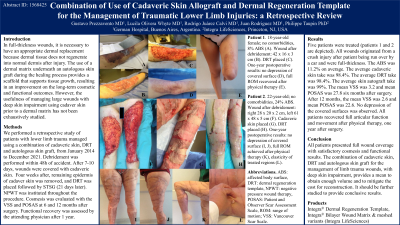Case Series/Study
(CS-116) Combination of Use of Cadaveric Skin Allograft and Dermal Regeneration Template for the Management of Traumatic Lower Limb Injuries: a Retrospective Review

In full-thickness wounds, it is necessary to have an appropriate dermal replacement because dermal tissue does not regenerate into normal dermis after the injury. The use of a dermal matrix underneath an autologous skin graft during the healing process provides a scaffold that supports tissue growth by enabling the influx of cells that will function as dermal cells, resulting in an improvement on the long term functional and cosmetic results. However, the usefulness of managing large wounds with deep skin impairment with both cadaver skin and dermal matrix has not been, to date, exhaustively studied.
Methods:
We performed a retrospective study of patients with lower limb trauma managed using a combination of cadaveric skin, Dermal Regeneration Template (DRT) and autologous skin graft, at the Hospital Aleman (Buenos Aires, Argentina), from January 2014 to December 2021. Cosmesis was evaluated with the Vancouver Scar Scale (VSS) and Patient and Observer Scar Assessment Scale (POSAS), at 6 and 12 months after surgery. Functional recovery was assessed by the attending physician and physical therapist, after 1 year.
Results:
Five patients were treated. The affected body surface area was 11.2% on average. The average cadaveric skin take was 98.4%. The average DRT take was 98.4%. The average skin autograft take was 99%. The mean VSS was 3.2 and mean POSAS was 27.8, six months after surgery. After 12 months, the mean VSS was 2.6 and mean POSAS was 22.6. All patients recovered full articular function and movement after physical therapy, one year after surgery. No depression of the covered surfaces was observed.
Discussion:
All patients presented full wound coverage with satisfactory cosmesis and functional results. The combination of cadaveric skin, DRT and autologous skin graft for the management of limb trauma wounds, with deep skin impairment, provides promising results which should be further studied to provide conclusive results.
Trademarked Items: Integra® Dermal Regeneration Template, Integra® Bilayer Wound Matrix
References:

.png)